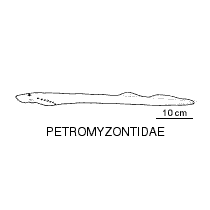- Classification
- PETROMYZONTIDA
- PETROMYZONTIFORMES
- MORDACIIDAE
-
Fish Classification
-
Class
PETROMYZONTIDA Lampreys -
Order
PETROMYZONTIFORMES Lampreys -
Family
MORDACIIDAE Lampreys -
Genera
Mordacia(2)
Family MORDACIIDAE
More Info
|
Family Taxonomy |
The family comprises 43 species in three subfamilies. Members of two subfamilies are found in Australian waters: the Geotriinae with a single species, Geotria australis and the Mordaciinae, with a single genus and two species, Mordacia mordax and M. praecox. Some authors have elevated the subfamilies to family status. |
|
Family Distribution |
Lampreys are antitropical in distribution, living in temperate rivers, streams and coastal areas of the northern hemisphere above 30°N and in the southern hemisphere in South Africa, South America, New Zealand and Australia below 30°S. |
|
Family Size |
To 90 cm. |
|
Family Feeding |
Although some adult lampreys are parasitic on other fishes, most species are non-parasitic. Parasitic lampreys feed on other fishes, attaching to the prey with their sucking disc and rasping away flesh with their toothy tongue. |
|
Family Reproduction |
Lampreys breed in freshwater streams, where the eggs hatch into filter feeding larvae known as ammocoetes. While some species spend their enitre lives in freshwater, many species are anadromous, migrating to the sea to mature before returning to spawn in freshwater rivers and streams. |
|
Family Commercial |
Although no fishery exists in Australia, lampreys have long been been consumed by humans. They are often considered a delicacy and their populations have been reduced by overfishing in many parts of the world. Lampreys are also sold as bait in some countries. |
|
Family Conservation |
The Non-parasitic Lamprey, Mordacia praecox, is listed as Vulnerable on the 2011 IUCN Red List of Threatened species. |
|
Family Remarks |
Lampreys have have a poor fossil record, possibly because of their cartilaginous skeletons. In 2006, the oldest known fossil lamprey dating back to the Devonian period, 360 million years ago, was found in South Africa. |
|
Author |
Dianne J. Bray |
References
Allen, G.R., Midgley, S.H. & Allen, M. 2002. Field guide to the freshwater fishes of Australia. Perth: Western Australian Museum 394 pp.
Collin, S.P. 2009. Early evolution of vertebrate photoreception: lessons from lampreys and lungfishes. Integr. Zool. 4(1): 87-98.
Collin, S.P., Davies, W.L., Hart, N.S. and Hunt, D.M. 2009. The evolution of early vertebrate photoreceptors. Philosophical Transactions of The Royal Society B-Biological Sciences, 364 1531: 2925-2940.
Davies, W.L., Collin, S.P. & Hunt, D.M. 2009. Adaptive Gene Loss Reflects Differences in the Visual Ecology of Basal Vertebrates. Molecular Biology and Evolution, 26 8: 1803-1809.
Gomon, M.F., D.J. Bray & R.H. Kuiter (eds). 2008. Fishes of Australia’s Southern Coast. Reed New Holland Press, Chatswood, Australia. 928 pp.
Hardisty, M.W. & I.C. Potter (eds). 1971. The Biology of Lampreys. Academic Press, London, 2 vols.
Hubbs, C.L. & Potter, I.C. 1971. Distribution, phylogeny and taxonomy. pp. 1–65 figs 1–112, in Hardisty, M.W. & Potter, I.C. (eds) The Biology of Lampreys. London: Academic Press Vol. 1
Janvier, P. 1996. Early vertebrates. Oxford Monographs in Geology and Geophysics, 33, Oxford University Press, Oxford.
Mee-mann Chang et al. 2006. A lamprey from the Cretaceous Jehol biota of China. Nature 441(7096): 972–974.
Neira, F.J., J.S. Bradley, I.C. Potter F.L.S. & R.W. Hilliard. 1988. Morphological variation among widely dispersed larval populations of anadromous southern hemisphere lampreys (Geotriidae and Mordaciidae). Zoological Journal of the Linnean Society 92(4): 383-408.
Nelson, J.S. 2006. Fishes of the World. John Wiley & Sons, New Jersey, 601 p.
Potter, I.C. 1980. Ecology of larval and metamorphosing lampreys. Canadian Journal of Fisheries and Aquatic Sciences 37: 1641-1657.
Potter, I.C. 1986. The distinctive characters of southern hemisphere lampreys (Geotriidae and Mordaciidae). in Uyeno, T., Arai, R., Taniuchi, T. & Matsuura, K (eds) Indo-Pacific Fish Biology. Proceedings of the Second International Conference on Indo-Pacific Fishes. Tokyo: Fishes The Ichthyological Society of Japan 985 pp.
Potter, I.C. 1996. Shortheaded lampreys, pp. 32-35, In : McDowall, R.M. Freshwater fishes of south-eastern Australia. Reed Books, Chatswood, Australia. 247 p.
Potter, I.C. & Hilliard, R.W. 1987. A proposal for the functional and phylogenetic significance of differences in the dentition of lampreys (Agnatha: Petromyzontiformes). Journal of Zoology 212: 713-737.
Potter, I.C. & Strahan, R. 1968. The taxonomy of lampreys: Geotria and Mordacia and their distribution in Australia. Proc. Linn. Soc. Lond. 179(2): 229–240 figs 1–2
Strahan, R. 1980. Family Mordaciidae: short-headed lampreys; Family Geotriidae: pouched lamprey. pp. 38–43 6 figs, in McDowall, R.M. (ed.) Freshwater Fishes of South-eastern Australia. Sydney: A.H. & A.W. Reed 208 pp. figs
Wager, R. 1996. Mordacia praecox. In: IUCN 2011. IUCN Red List of Threatened Species. Version 2011.1. . Downloaded on 18 September 2011.





